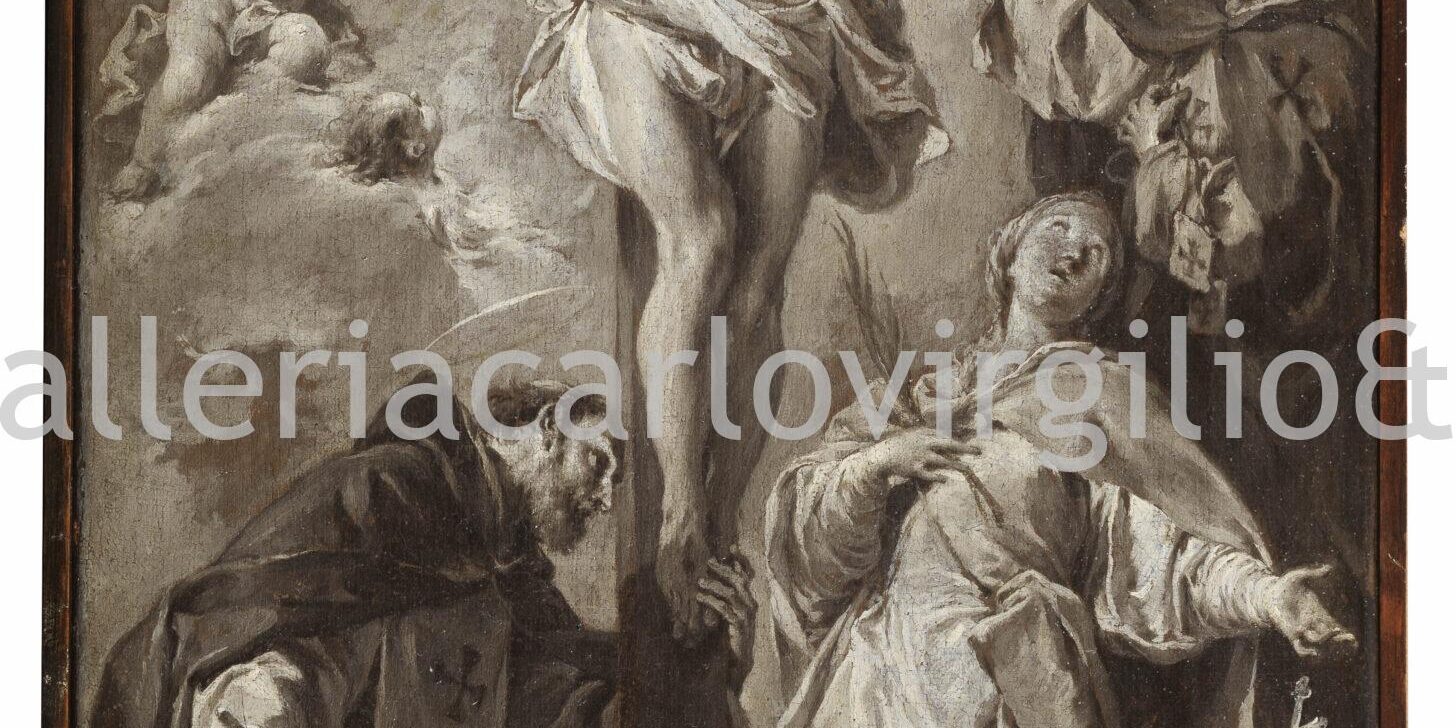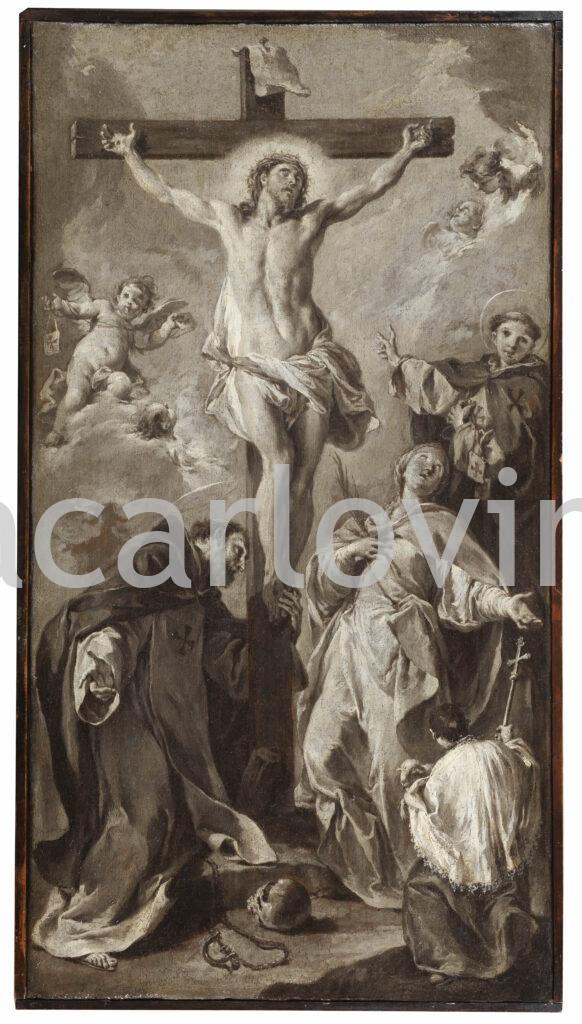| NOT AVAILABLE

Giambattista Pittoni
Venice 1687 – 1767
Crucifixion with Saint Agnes and Trinitarian Saints • 1730/40 ca.
olio on canvas, 62×33,2 cm
Bibliography: Zava Boccazzi 1974, p. 200, fig. 265; Zava Boccazzi 1979, p. 156, n. 168, fig. 470.
This small grisaille on the original canvas, in a perfect state of conservation, was made known by Franca Zava Boccazzi in 1974 (p. 200, fig. 265) and later published in her monograph on Giambattista Pittoni (Zava Boccazzi 1979, p. 156, n. 168, fig. 470). Although the attribution to Pittoni has never been questioned – given the high quality of the work, painted with freshness and smoothness, as well as the composition, presenting as it does all the characteristic traits of the artist’s figurative universe, from the structure that unfolds on the diagonal to his physiognomic types, and a pervasive atmosphere as theatrical as it is restrainedly and devotionally sentimental – the same cannot be said of the subject. For Zava Boccazzi, the two priests with signs of the cross on their chests and scapulars, added to the chain lying at the foot of the cross, recalls the order of Mercy, protectors of the condemned. In fact, due to the presence of the martyr Agnes, recognisable in the lamb carried by the cleric whose back we see in the foreground, it is more likely that the two holy fathers were from the Trinitarians, of which Saint Agnes is patron. Indeed among the prerogatives of the order is the liberation of slaves, and the chain is one of the attributes belonging to John of Matha, who founded the Trinitarians in 1193, and recognisable as the figure worshipping the crucifix in the left foreground. Whilst the second monk could be John Baptist of the Conception, champion of the order’s reform in 1599, whose initiates took the name of Barefoot Trinitarians. Hence the sandaled foot in the foreground belonging to John of Matha could allude to the reformed order that decreed the holy fathers could use that type of footwear. Worth nothing is that from 1721 the Venetian Senate expressed the desire to welcome the Barefoot Trinitarians in Venice, with the aim of freeing slaves, in particular Venetian subjects, a proposition that was put into practice in 1723 when it was decided to grant the order a monastery on the coastal island of Pellestrina and the right to celebrate mass at the Sanctuary of the Madonna dell’Apparizione, whose construction was completed that year to a design by Andrea Tirali. The Trinitarians would remain on Pellestrina until 1735, the year in which due to disagreements with the Venetian Senate related to almsgiving, the holy fathers decided to leave the land of the Serenissima. The presence of the scapular reiterated in the grisaille might also be a reference to the miraculous image of the Madonna del Carmine conserved in the sanctuary at Pellestrina. If we link Pittoni’s work to an as yet unknown commission for the Trinitarians, a dating of the 1730s would be the most likely. It falls into the vast production of chiaroscuro typical of Pittoni’s modus operandi, and recalled by Giannantonio Moschini (1806, III, p.70): «Pittoni had the habit of painting his model in oil in chiaroscuro and his models were highly appreciated.» There are at least a dozen in the painter’s catalogue, variously assessed by critics as preparatory models or recollections of more involved works in larger dimensions. What is certain is that the collectors’ taste for small format paintings in Venice was sustained throughout the eighteenth century: suffice it to think of the Gian Maria Sasso collection, where numerous “models” by eighteenth century painters come together, almost forming a dedicated picture gallery (Giuseppe Pavanello, in Sebastiano Ricci 2010, p. 18) which could not fail to feature Giambattista Pittoni, one of the great interpreters of this pictorial season.
Andrea Chiocca
Bibliography:
Contarini 1745
Giovanni Battista Maria Contarini, I lidi veneti difesi dalla santiss. Vergine o sia Storia della immagine, chiesa, e convento della B. Vergine di Pellestrina, Venezia 1745.
Moschini 1806
Giannantonio Moschini, Della letteratura veneziana del secolo XVIII fino a’ nostri giorni, III, Venezia 1806.
Sacerdoti 1965
Alberto Sacerdoti, I padri Trinitari Scalzi a Venezia (1723-1735), in “Studi Veneziani”, VII, 1965, pp. 433-441.
Zava Boccazzi 1974
Franca Zava Boccazzi, Per il catalogo di Giambattista Pittoni: proposte e inediti, in “Arte Veneta”, 28, 1974, pp. 179-204.
Zava Boccazzi 1979
Franca Zava Boccazzi, Pittoni: l’opera completa, Venezia 1979.
Zava Boccazzi 1984
Franca Zava Boccazzi, Considerazioni sul «modelletto» di Giambattista Pittoni, in Beiträge zur Geschichte der Olskizze vom 16. bis zum 18. Jahrhunder, Braunschweig 1984, pp. 94-105.
Pavanello 2010
Giuseppe Pavanello, «Questo picciolo è l’originale», in Sebastiano Ricci: il trionfo dell’invenzione nel Settecento veneziano, catalogo della mostra (Venezia, Fondazione Cini, 24 aprile – 11 luglio 2010), Venezia 2010, pp. 13-27.
Sebastiano Ricci 2010
Sebastiano Ricci: il trionfo dell’invenzione nel Settecento veneziano, catalogo della mostra (Venezia, Fondazione Cini, 24 aprile – 11 luglio 2010), Venezia 2010.
The Carlo Virgilio & C. Gallery searches for works by Pittoni Giambattista (1687-1767)
To buy or sell works by Pittoni Giambattista (1687-1767) or to request free estimates and evaluations
mail info@carlovirgilio.co.uk
whatsapp +39 3382427650
